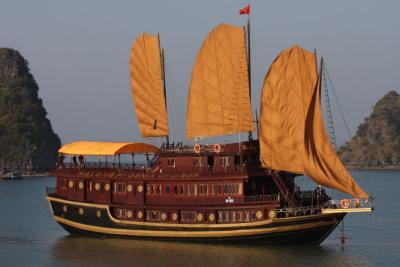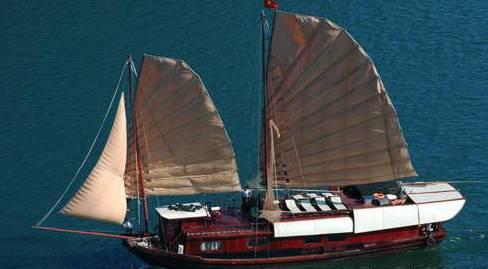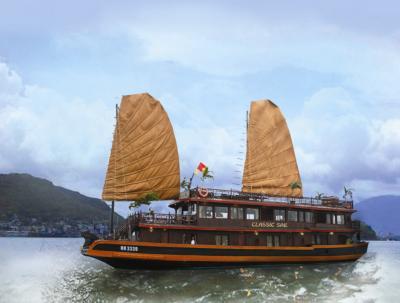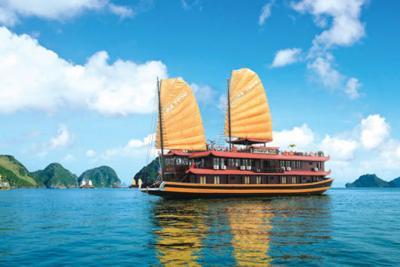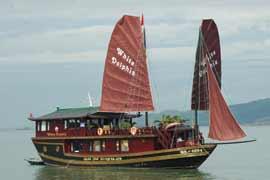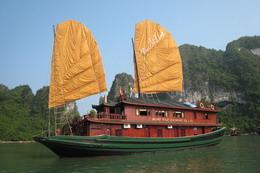The drifters…
Published: 14/11/2008 05:00
| VietNamNet Bridge - A riverside community by Lo River in Tuyen Quang province lives in constant fear of the next big storm
Hoang and his family live along the edge of the Lo River in Tuyen Quang province. Here there are hundreds of ‘floating huts’ which are officially part of Minh Xuan, Tan Quang and Phan Thiet quarters in Tuyen Quang town. This is not a romantic riverside existence. This is where the sole purpose of life is survival. Each household lives on what more fortunate people would regard a pittance, which is earned from fishing, collecting trash or by raising pigs. But this is also a place steeped in history. This is where Tran Nguyen Han, a famous general and military strategist, who served under the later Le dynasty killed himself in 1429 after losing favour with the king’s sycophantic and conspiring ministers. Legend has it that when Han killed himself by his own sword on his boat in the middle of the river, a fierce storm appeared and carried the boat away. Decades after his death he was pardoned by King Le Nhan Tong. This is also where Ho Chi Minh’s Viet Minh troops rallied time and time again against French forces between 1945 and 1954. Every Vietnamese student will be told of Chien Thang Song Lo (The Triumphs on the Lo river). This is a place of poetry and songs. Epic songs such as Van Cao’s Truong ca song Lo (The Lo river Epic) or Pham Duy’s Tieng hat tren song Lo (A song on the Lo river) have immortalised the river. But today this is a place of harsh realities. The residents, some of whom have lived here for generations, cannot recall how many times their huts have been ripped asunder by natural calamities. But nobody has anywhere else to go so this is where they stay. Living on the edge Seen from the Nong Tien Bridge, the river looks like a roll of silk in the afternoon sunlight. Looking down at this peaceful and tranquil setting, I can’t imagine how this gentle river floods its banks when the storms come. Each hut is about 10-15 square metres and is fixed with the help of vertical bamboo poles and a rope that connects the hut to a spike on the river bank. The residents use the river water for daily activities such as washing themselves, washing clothes, and, after sterilising it, for cooking. Toilets are nothing but a hole in the raft. The waste is dumped directly into the river. Phi Van Nghia, who is 80 years old, is lying sick on his bed, which is the floor of his hut. Nghia’s hut is divided into two sections with one room for living and sleeping and another for raising pigs and ducks. Amongst the river community, there seems to be a small farmyard of animals. Nghia has eight kids all of whom are now married and still living by the river. Two of his kids, both carpenters by trade, still live in his house. “Nobody goes very far in this season as floods and storms can come at any time,” he says. “I remember that two years ago, after a fierce storm the water level went shooting up and the huts were dragged up onto the land. Many huts were completely destroyed.” Next door to Nghia, 51-year old Ngo Thi Phuong politely invites me to cross the rickety bamboo plank to her hut while she prepares her dinner. She tells me it cost about VND8- VND10 million ($479-$599) to build her home, a sum of money, which would take her family on average a year and a half to save up. There is no electricity or running water. “My family has lived here for four generations,” she says. “Last year our hut capsized in a storm and we were left to starve as we lost everything.” Phuong, who sells bread for a living, makes just enough money to buy rice each day. Her husband is bed-ridden with tuberculosis. “The doctors said he needs more treatment but he had to come home from hospital as we have no more money left to pay his medical bills,” she says. Dreamland.. This is where people dream of living on land. But everywhere prices continue to rise while the residents of this floating community only earn enough to survive. This is where the average daily income is just VND10,000 to VND15,000. This is where people’s houses are worth nothing. Nowhere does the mounting economic gulf between classes in Vietnamese society seem so apparent. “Life here is miserable but we have got used to it as we were born here,” says 31-year old Vu Anh Tuan, a father of two. Tuan’s kids go to school but most children from the community end up quitting to help their family earn more money. Sitting on the riverbank, Tuan says that he wants to have a paddy field to grow rice. “Then I would have enough cooking for the year,” he says. Last year, he used his family’s modest savings to raise fish in tanks so he could hopefully earn a little extra income. A week after setting the tanks up a storm swept it all away. “We just want a future for our children,” he says, pointing to a group of kids running around a raft with a paper kite. The local authorities have visited the community but so far no one has come up with any kind of a solution to help these residents build better houses that would survive storms. Just as I am about to leave dark clouds roll across the sky. Instinctively Tuan’s son runs past his father, grabs a large rope and secures their hut more tightly to a tree on the riverbank. (Source: Timeout) |
Provide by Vietnam Travel
The drifters… - Travel - News | vietnam travel company
You can see more
- Travel trends in 2023
- In the spring, Moc Chau is covered in plum blossoms.
- Top 3 Special festivals in Vietnam during Tet holiday - 2023
- 5 tourist hotspots expected to see a spike in visitors during Lunar New Year 2023
- 12 Days Cycling From Vietnam to Laos
- Why You Should Cycle To Cuc Phuong National Park?
- Top 10 Must-see Sights In Hanoi, Vietnam
- The Most Wonderful Destinations In Sapa
enews & updates
Sign up to receive breaking news as well as receive other site updates!
- Banh Đa Cua - a traditional Hai Phong specialty
- Exploring Lai Chau cuisine
- Hanoi ranked top 3 cuisine in the world in 2023
- Beautiful resorts for a weekend escape close to Hanoi
- Travel trends in 2023
- In the spring, Moc Chau is covered in plum blossoms.
- The Most Wonderful Destinations In Sapa
- Top 3 Special festivals in Vietnam during Tet holiday - 2023
- 5 tourist hotspots expected to see a spike in visitors during Lunar New Year 2023
- How To Make Kitchen Cleaned
-
vietnam travel
http://www.vietnamtourism.org.vn " Vietnam Tourism: Vietnam Travel Guide, Culture, Travel, Entertainment, Guide, News, and...
-
Vietnam culture, culture travel
http://travel.org.vn " Vietnam culture
-
Vietnam travel, vietnam travel news, vietnam in photos
http://www.nccorp.vn " Vietnam travel, vietnam travel news, vietnam in photos
-
Vietnam tourism
http://www.vietnamtourism.org.vn " The official online information on culture, travel, entertainment, and including facts, maps,...
-
Vietnam Travel and Tourism
http://www.vietnamtourism.org.vn/ " Vietnam Travel, Entertainment, People, Agents, Company, Vietnam Tourism information.
-
Information travel online
http://www.travellive.org "Information travel online




